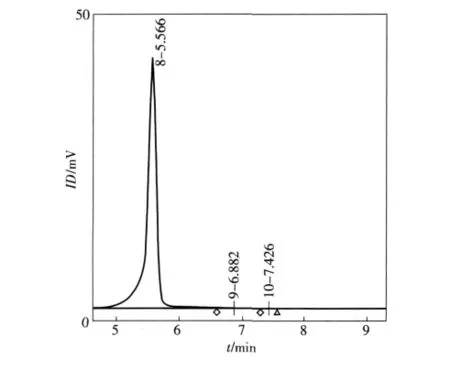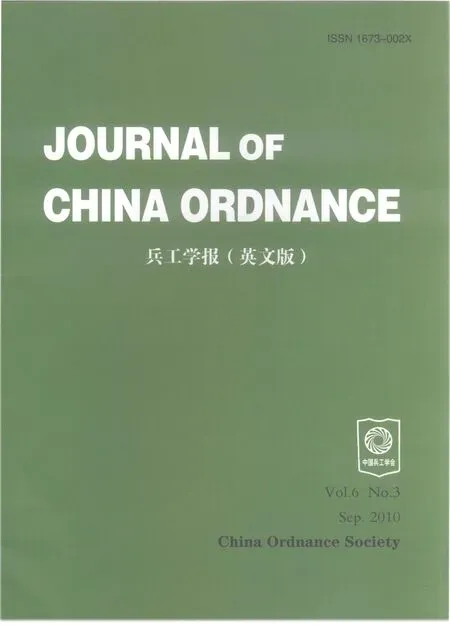Quantitative Analysis of Components in OC-CS Sprays by High Performance Liquid Chromatography with Double Wavelength UV Detection
SUN Li-quan(孙立权),CHEN Zhen-he(陈振贺),QIU Ri-xiang(邱日祥),WANG Li-jing(王莉晶),QIAN Wei(钱伟),GENG Li-na(耿利娜),
LUO Ai-qin(罗爱芹)1(1.School of Life Science,Beijing Institute of Technology,Beijing 100081,China;2.The First Research Institute of Ministry of Public Security,Beijing 100044,China)
Introduction
OC-CS spray,a novel self-defense weapon for police,has been widely used[1].The lachrymatory spray as a nonfatal weapon is usually packed with irritant chemicals,called stimulants,which can irritate eyes,nose,throat and skin,and make the lose of sense temporally.People will be poisoned in short time when contact with such drugs and will recover completely within a few minutes or a few hours when broken them away without any treatment.Now the main stimulants used for military or police throughout the world are chloracetophenone(CN),o-chlorobenzalmalononitrile(CS),adamsite(DM),Dibenz[b,f](1.4)oxazepine(CR),capsaicinoids(OC),dihydrocapsaicin(DC),etc.Among the above stimulants,CS,OC and DC were widely used[2].The power of sprays is determined by the content of stimulants[2].The main components of sprays used in China are CS,OC and DC or the mixture of them[3].The safety of CS,OC and DC is much better than CN.The content amount of the sprays is the important parameter to estimate the quality of sprays.To detect the content of CS,gas chromatography(GC)or chemiluminescence is usually used,while high performance liquid chromatography(HPLC)is commonly used for the measurement of OC[8].Therefore,most methods for detection of specific content or mixture in sprays often include both of GC and HPLC.In this paper,HPLC method with a photodiode array detector is proposed.The quantitative measurements for CS,OC and DC can be performed within one injection by measuring UV spectrum and calculating peak areas of the contents.This method can leave out the use of GC and hence save time and expenditure with comparable accuracy.
1 Experiments
1.1 Instruments and Solvents
Waters 2690HPLC system was used in the experiments.The system includes Waters 515 binary gradient pump,Waters 717 plus auto-sampler,Waters 996 photodiode array detector and Waters empowered software(American,Waters Corp);an electric balance(Sartorius corp)was used to measure the solvent.The Kromasil C18 chromatography column is(4.6 mm×250 mm,5 μm Alltech corp.)is used to detect the components.Methanol(HPLC,Fisher),CS,OC and DC(99% ,Aldrich)are available from market.
1.2 Chromatography Conditions
Kromasil C18 column(4.6 mm ×250 mm,5 μm)was selected in the experiments.Two UV wavelengths to be detected are 227 nm and 300 nm.The flow rate is 0.8 mL/min and the column temperature is 25℃.The mobile phase is the mixture of methanol and water,V(CH3OH)/V(H2O)=4/1.The injection volume is 10 μL.
1.3 Preparation and Measurement of Samples
Sprays'contents were injected into sealed containers and then weighed by electric balance with accuracy of 0.000 1 g,then the solvent was diluted by methanol and weighed.Every sample was measured 3 times using HPLC.The chromatographic peaks at 227 nm and 300 nm were extracted and their integral areas were calculated.
1.4 Preparation of Working Curves
First,6.2 mg CS was diluted in 2.0 mL methanol(total quality is 1.616 7 g)to prepare initial CS solution.Then 336.0 mg,252.0 mg,118.0 mg,84.0 mg and 34.0 mg of above initial CS solution were respectively added to 2 mL with methanol in flask and correspondingly got the standard solutions with their weights of 1.610 3 g,1.620 9 g,1.615 4 g,1.616 2 g,1.613 9 g.The samples of compounded CS and methanol solution were injected into HPLC.After measurement,the working curves of CS can be plotted with weight concentration(mg/g)as its X-axis.Therefore,the regression equation of CS can be obtained.
First,22.0 mg OC was diluted in 5.0 mL methanol(total quality is 3.905 4 g)to prepare initial OC solution.Then 403.0 mg,300.0 mg,210.0 mg,103.0 mg and 41.0 mg of above initial solution were respectively added to 2 mL with methanol in flask and correspondingly got the standard solution with their weights of 1.606 5 g,1.611 4 g,1.618 5 g,1.610 1 g and 1.602 3 g.Following the procedure for CS,the working curves and the regression equation of OC can be obtained.
First,20.4 mg DC was diluted in 5.0 mL methanol(total quality is 3.904 9 g)to prepare initial DC solution.Then 400.0 mg,299.0 mg,211.0 mg,102.0 mg and 42.0 mg of above initial solution were respectively added to 2 mL with methanol and correspondingly got the standard solutions with their weights of 1.611 1 g,1.612 5 g,1.609 3 g,1.617 4 g and 1.620 5 g.The working curves and the regression equation of DC can be obtained.
2 Results and Discussions
2.1 Determination of Experimental Conditions
2.1.1 Determination of Chromatographic Column
It was reported that the detection of OC and DC could be performed with a reverse phase C18 chromatographic column[4],while CS was usually detected by GC and no reports was found by HPLC.But using Kromasil C18 column(4.6 mm×250 mm),OC,DC and CS could be separately found with baseline and the remaining time of CS is 5.6 min.Therefore,Kromasil C18 column is used in the experiments.
2.1.2 Determination of Detection Wavelengths
Figure 1 shows the UV spectrum of OC,DC and CS obtained by photodiode array detector.It can be seen that UV adsorption shapes of OC and DC are similar and two maximum adsorption peaks are at 227 nm and 279 nm,respectively.The first maximum adsorption wavelength of CS is 300 nm,while no UV adsorption of OC and DC is observed around 300 nm.It is obvious that the detection at maximum absorption wavelengths without interference is more effective and accu-rate.Hence,the detection wavelength of OC and DC is set at 227 nm and CS at 300 nm.

Fig.1 Ultraviolet spectroscopy of CS,OC and DC
2.1.3 Selection of Mobile Phase
The mobile phase for detection of OC and DC by HPLC are usually the mixture of methanol and water or the mixture of acetonitrile and water.In methanol and water system,the efficient separation among CS,OC and DC is able to be achieved.Different ratios of methanol and water(v/v,4∶1,2∶1,1∶1)were also compared,and the ratio of 4∶1 is selected as the mobile phase at last.
2.1.4 Determination of Working Curves
From working curves of CS,OC and DC under selected chromatographic conditions,the regression equations are obtained
CS:y=4.400×107x+9.091×105,r=0.9998,concentration range for CS:0.11~1.8 mg/g;
OC:y=1.157×107x+2.873×105,r=0.999 9,concentration range for OC:0.10~2.4 mg/g;
DC:y=1.251 ×107x+7.618×104,r=0.9998,concentration range for DC:0.10 ~1.6 mg/g.
2.1.5 Accuracy of the Analytical Method
200.0 mg CS initial solution,200.0 mg OC initial solution and 200.0 mg DC initial solution(see section 1.4)are mixed to a 5 mL volumetric flask and then methanol is added into the flask.The weight of the solution is 3.910 1 g.After stirring,the solution is filtered through a 0.22 μm filtering membrane.Then take the solutions of 10 μL and inject into the HPLC system.This operation is repeated for 5 times to check the area variation of three different components.The relative standard deviations for OC,DC and CS are 0.16%,0.27% and 0.31%,respectively.That means the method has good accuracy.
2.1.6 Stability of the Analytical Method
Take solution obtained from above section 2.1.5 as the samples and inject into HPLC system every 2 hours with 10 μL solution each time.The operation is repeated for 6 times to check the stability of the analytical method.It is observed that,within 12 hours,the relative standard deviations for OC,DC and CS are 0.14%,0.40% and0.21%,respectively.The HPLC method shows its strong stability for detecting CS,OC and DC.
2.2 Rate of Recovery Test
Take the initial solutions of 400.0 mg OC,200.0 mg DC and 100.0 mg CS.Then add them to solutions obtained from section 2.1.5 for testing.The recovery test is performed under chromatographic conditions determined in section 1.2.The results are shown in Table 1.The average recovery efficiencies of three different components are 100%,98%and 99%,respectively,with the maximum RSD less than 3.0%.The result of recovery efficiency is satisfied.

Table 1 Recoveries of three components(n=3)
2.3 Analyses of the Samples
Because the solvent for stimulants is usually ethanol and is easy to volatilize,the samples are prepared in sealed containers.In addition,the weight of samples is also calculated using subtraction method.That is,the sample weight of spray equals the deference between the amount after spraying and before spraying.Samples are then analyzed according to the operation as the same as described in section 1.4.The concentrations of stimulants in spray can be worked out from the working curves.Fig.2 shows the chromatogram at 227 nm,the OC and DC peaks can be found from the curve.Fig.3 shows the chromatogram at 300 nm.It can be seen only CS peak is detected,and no peaks for OC and DC are detected.The attribute for CS,OC and DC could be determined by comparison of their retention time.Although the weights of the samples are different,the concentrations of these components are quite similar in one batch,as shown in Table 2.

Fig.2 Chromatogram at 227 nm of OC and DC

Fig.3 Chromatogram at 300 nm of CS
3 Conclusions
A new method for analyzing CS,OC and DC insprays has been proposed and its experiment has been described in detail.In one injection,concentrations of CS,OC and DC can be calculated from working curves by HPLC method.HPLC method could be a good option to displace GC method,especially for CS.This method is fast and simple.It also has the satisfactory linear relationship between UV absorption and solutions concentration.It is an instructive trial to modify the standard method for detection of related components in the spray.

Table 2 Results of two products in one batch
[1]WANG Yan-ji,LI Wen-jun.Chemistry in public security field[J].Chemistry,2006,(12):902 -908.(in Chinese)
[2]XIAN Xing-ping,GUO San-xue,LIU Lu-sheng.Green design of small arms[J].Basic Technology of National Defense,2007,(1):49 -53.(in Chinese)
[3]LIAO Min.OC-CS spray for police[J].People Police,2007,(10):46 -47.(in Chinese)
[4]YANG Li-ming.New weapon-OC spray of tear bomb[J].Small Arm,2002,(1):16-17.(in Chinese)
[5]Ministry of Public Security.Standard of single police equipment[M].Beijing,Ministry of Public Security,2006.(in Chinese)
[6]ZHOU Zhen-zhong,ZHAO Yan-wu,WANG Xian-wei.Gaschromatographic analysis of CS in spray aerosol[J].J Eng Coll Armed Police Force,2002,2:24 -26.(in Chinese)
[7]XIANG Yu-lian,LIU Guo-hong,LI Shan-mao,et al.The chemiluminescence analysis of o-chlorobenzyl-idenemalononitrile in cetyltrimethylammonium bromide reversed micelle medium[J].Chinese J Anal Chem,2002,(4):436-439.(in Chinese)
[8]WANG Yan,XIA Yan-bin,XIONG Ke,et al.Determination of capsaicinoid content in capsicum products with HPLC-UVD[J].Food Science,2006,(9):193 - 196.(in Chinese)
- Defence Technology的其它文章
- Analysis on Velocity Characteristics of Cavitation Flow Around Hydrofoil
- Influence of Accelerated Aging on Detonation Performance of Explosives
- Research on Additional Loss of Guidance Optical Fiber
- An HLA/RTI Architecture Based on Multi-thread Processing
- A Fuzzy Adaptive Algorithm Based on“Current”Statistical Model for Maneuvering Target Tracking
- A New Chaotic Genetic Hybrid Algorithm and Its Applications in Mechanical Optimization Design

